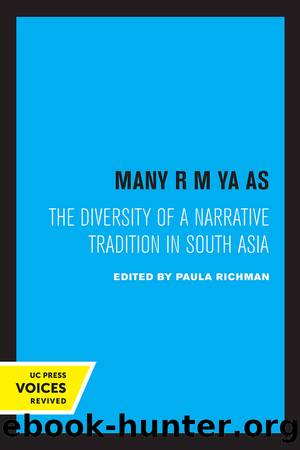Many Ramayanas by 2023

Author:2023
Language: eng
Format: epub
ISBN: 9780520911758
Publisher: University of California Press
Published: 2023-05-11T00:00:00+00:00
EIGHT
Creating Conversations:
The Rama Story as Puppet Play in Kerala
Stuart H. Blackburn
The Rama story in India is an oral tradition. Although texts do stabilize certain variants, and may engender other variants, the diversity of the traditionâthe many Rdmdyanasâis a function of the many genres, the many languages, and the many occasions on which the Rama story is orally performed. By tale-tellers and epic-singers, temple pundits and schoolteachers, and any number of unknown tellers and tellings, the story is spoken, chanted, sung, mimed, retold, and explained. Several contributions to this volume draw attention to this variety of tellers and tellings, and implicitly to their audiences. Here, too, is diversity. The audience may be the immediate listeners, whose role in performance varies from that of active participant (as respondent to a spoken line) to silent spectator. Some audiences are physically absent, such as patrons, who are meant only to overhear the performance or learn of it later. The audience may also be a god or goddess, as when a text is ritually performed with no human onlookers. And combinations of these audiences often coexist in a single performance event.1
Audiences seem especially important in the Rama story tradition. Several major texts,/ including the Rdmcaritmdnas and the Adhydtma Ramdyana, are cast in dialogue form, Siva narrating the story to Parvati. Even in Valmikiâs variant, Narada summarizes the first chapter to the poet. Whether or not this focus on narration offers further evidence for the essentially oral nature of the Ramdyana, these texts include another type of audience: an internal audience, created by tellers within their text. This internal audience is what I found in studying performances of the shadow puppet play in Kerala. The puppeteers did not perform for a conventional audience, since few people, often absolutely no one, remained throughout the night to hear their chanting and exegesis of the Rama story; instead, they created conversations among themselves.
The Kerala shadow puppet play itself illustrates the diversity of the Ramdyana tradition in that it performs a classical Tamil text in a Malayalam folk context.2 The plays are presented in a long series of overnight performances, often running twenty or more nights, as part of the annual festival in central Kerala to the goddess Bhagavati. Although the puppet stage, called a âdrama house,â is built outside the temple proper, the performances are explicitly linked to the temple: its lamp is used to light the little lamps inside the drama house that cast the puppet shadows on the screen; the screen is handed to the puppeteers by the temple oracle-priest on the first night of performance; each night the performance is blessed by the oracle-priest; and each night hundreds, sometimes thousands, of individuals make donations to the puppeteers (in advance of the performance), who in return will ask the goddess to bless them, cure their leg sores, return runaway cousins, or restore a brotherâs lost livestock. From this public perspective, the puppet plays are recitations, an extended verbal ritual (puja) intended to win benefits for its patrons.
Textually,
Download
This site does not store any files on its server. We only index and link to content provided by other sites. Please contact the content providers to delete copyright contents if any and email us, we'll remove relevant links or contents immediately.
4 3 2 1: A Novel by Paul Auster(11075)
The handmaid's tale by Margaret Atwood(6875)
Giovanni's Room by James Baldwin(5896)
Big Magic: Creative Living Beyond Fear by Elizabeth Gilbert(4736)
Asking the Right Questions: A Guide to Critical Thinking by M. Neil Browne & Stuart M. Keeley(4600)
On Writing A Memoir of the Craft by Stephen King(4221)
Ego Is the Enemy by Ryan Holiday(4003)
Ken Follett - World without end by Ken Follett(3984)
The Body: A Guide for Occupants by Bill Bryson(3817)
Bluets by Maggie Nelson(3724)
Adulting by Kelly Williams Brown(3681)
Guilty Pleasures by Laurell K Hamilton(3601)
Eat That Frog! by Brian Tracy(3527)
White Noise - A Novel by Don DeLillo(3443)
The Poetry of Pablo Neruda by Pablo Neruda(3372)
Alive: The Story of the Andes Survivors by Piers Paul Read(3320)
The Bookshop by Penelope Fitzgerald(3237)
The Book of Joy by Dalai Lama(3237)
Fingerprints of the Gods by Graham Hancock(3223)
